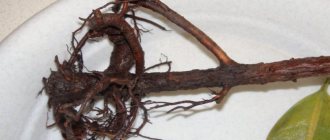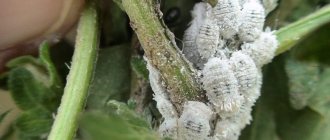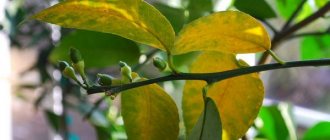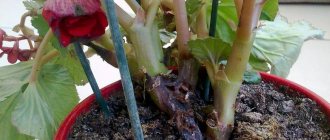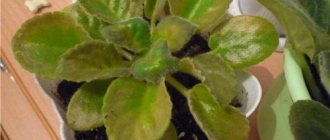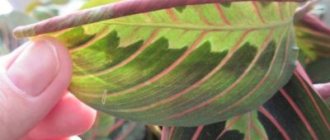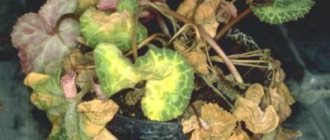Common problems
If you do not comply with the growing conditions, then the ficus will not look healthy. It is not necessary that the bush is affected by insects or disease; sometimes the problem is due to insufficient lighting. Pale and yellowing of the leaves indicates a lack of the required amount of light. In this case, you just need to move the pot closer to the window, and in winter add artificial lighting.
The appearance of brown spots is a sign of a burn from direct sunlight.
It also happens that the falling of leaves and the appearance of blackening are the result of frostbite on the plant. You can revive the plant at home. The most important thing is to eliminate the source of the draft and create conditions for resuscitation. Under no circumstances should you water the flower; you need to wait until the soil dries well. The necessary moisture is provided by spraying the foliage with warm and settled water. As soon as new shoots appear, it is possible to resume watering and use Kornevin, a growth activator. "Orton Growth" is used as a top dressing 2 times every week.
If the flower dries out or has already dried up, then you need to restore it immediately. To do this, use high-quality watering and a lot of diffused light in combination with stimulants. The root system is freed from the soil and placed in water, waiting for new shoots to appear.
How to protect ficus trees from diseases
Proper care and attention is the best way to avoid diseases of any indoor plants. But sometimes it happens that ficus diseases appear already in the first days after its appearance. To avoid this, there are mandatory preventive measures that will protect you from this fate:
- When purchasing a flower, carefully inspect it for traces of parasites. The slightest manifestation of ficus leaf disease is a reason to refuse the purchase, or be ready to begin treatment;
- even if the ficus looks perfect, it is quarantined for a week, away from other plants; after time, if no signs of disease have appeared, it is installed in a permanent place;
- when arranging flowers, it is important to maintain a distance between them;
- wash with soapy water from time to time;
- When replanting, disinfect the soil, pots and trays with a weak solution of potassium permanganate.
Following these simple rules will save time, keep your home garden healthy and ready to serve its owners, delighting with its aesthetic appearance and clean indoor air.
Diseases
Ficus Benjamin diseases always develop due to unfavorable growing conditions. The main reasons for this are low temperatures (below 60°F) and overwatering. Effective tips for maintaining a healthy plant include using pathogen-free planting soil and container and disease-free seedlings. It is worth taking a closer look at common problems with ficus and how to solve them.
- Leaf fall . This is the most common problem for new growers and is usually caused by temperature changes. Ficus likes constant conditions, so it is necessary to maintain the same level of heat and humidity. A change in these two factors, even within 5-10 degrees, will cause leaves to fall. The only way to eliminate the problem is to stabilize the environment and continue to regularly water and fertilize the flower.
- Brown spots. Cercospora blight looks like tiny black spots on the leaves. In this case, they may turn yellow and fall off. The grower will need to remove diseased shoots and spray the plant with a specialized product, and subsequently prevent high humidity. The use of sulfur helps, it is sold in sprays. Copper-containing fungicides can be applied at the first sign of the disease to prevent its spread. Organic products will prevent spores from germinating.
- Anthracnose . This disease manifests itself as rusty spots on stems and leaves. When a problem occurs, remove diseased leaves and then practice good sanitation. Collecting and disposing of all affected plant parts and providing adequate light, water and fertilizer will strengthen the plant's ability to resist the fungus. Chemical treatments are rarely used because they can be harmful to occupants indoors.
- Juice oozes from a ficus tree. This condition is caused by the appearance of sucking pests. Mealybugs appear as small cottony clumps, and scales appear as white or black spots on the stems and body of the tree. The problem can be eliminated by using horticultural oils or a soap solution - 1 tablespoon of soap per 4.5 liters of water.
- The appearance of inflamed areas. Such swollen places can form on leaves (in large veins), stems, and sometimes roots, near stem cuttings. It is caused by a bacterium. It can be destroyed by removing affected plant parts to prevent spread. Using herbal sprays containing copper is an effective treatment for this condition.
- Black spots. Very small marks usually develop on the underside of the leaves. This is nothing more than a fungus; when the infection is very severe, the foliage turns yellow and falls off over time. Further spread of the disease can be prevented by removing infected areas and spraying with a fungicide. Spotting can also be caused by canker sores. The spots may appear rusty and at times ooze juice.
Diseases
A plant with weakened immunity is more often susceptible to diseases caused by various fungi. The following fungal diseases can occur in ficus plants:
Powdery mildew
Spots with a whitish coating similar to fluff appear on the leaves. It is easy to fight the disease only at the initial stage. Newly formed stains can be easily washed off with a solution of laundry soap. In more advanced cases, the affected leaves are removed and the ficus is sprayed with fungicides.
Anthracnose
The disease is manifested by rust-like spots that form along the edges of the leaves. Then holes appear in place of the spots. The ficus sheds diseased leaves and as a result can become completely bare. The disease can also be treated with fungicides.
Gray rot
Caused by mold whose spores become airborne when the leaf is shaken. As the lesion progresses, brown spots appear on the leaves and grow rapidly. The leaf blade completely darkens and the leaves fall off. Often the disease occurs in a stuffy and humid room that is not ventilated. All affected leaves must be removed and the plant treated with antifungal drugs. Watering during treatment is kept to a minimum.
Cercospora
Often the disease starts with excess humidity in the room. It is caused by a special fungus called Cercospora. The first symptoms can be noticed on the underside of the leaves in the form of small brown or black dots, which then increase in size. The leaves begin to turn yellow and fall off; in advanced cases, the ficus may die. Treated with anti-fungal agents.
Sooty mushroom
More often, the disease develops simultaneously with an attack by pests, since the fungus feeds on their secretions. Symptoms are the appearance of a black coating similar to soot on the leaf blades. It is difficult not to notice this disease. It is treated with special drugs.
Root rot
It is provoked by excessive watering. The disease cannot always be noticed on time, since it occurs in the ground. The root system stops working normally, which causes the death of the plant. It is destroyed, the pot is also thrown away.
Harmful insects
Some plants are better equipped to handle pests, while others need a little extra help. Before purchasing a ficus tree, it is important to research what problems are common with these beautiful trees.
- Mealybug. They are small white furry sucking insects that gather in large clusters. They may appear after watering as they crawl to the surface of the soil. They can be seen in areas of the plant where branches meet the main stem. There are several ways to treat insects. You can spray the foliage with horticultural oil or treat the soil with chemicals. If you don’t want to use chemicals, then spray a soap solution. The liquid is prepared at the rate of 1 tablespoon of soap per 4.5 liters of water.
- Centipedes. These are brown insects with a long body and many legs. If they appear, it is likely that the soil was not sterilized before the tree was planted in it. The best way to combat this problem is to change the soil and sterilize the new one. The pot should also be cleaned - this is the only way to ensure that the grower is free of pests.
- Shield. Like other insects, scale insects do not tolerate high humidity and soapy treatment. Saving a plant from it is not difficult, you just need to spend a little time on processing.
- Thrips. This is an insect that is difficult to get rid of and even more difficult to see because it is so small. You can inspect the foliage for the appearance of small dark spots, that is, waste that they leave on the ficus. To get rid of them, you first need to water the plant from the shower, then spray it with neem oil.
- Whiteflies . They often attack the flower. They immediately become visible due to their white coating. To prevent their occurrence, it is necessary to use neem oil sprays. Standard yellow sticky traps also work well.
- Spider mites. You can get rid of them with a simple soap solution or a strong shower.
- Aphid . When branches and leaves curl, this may be a sign that aphids have appeared, which, in turn, are also carriers of bacterial diseases. They get rid of it with an alcohol solution, which needs to be used to wipe the trunk and leaves.
Fungal and other diseases
If the leaves begin to fall in the fall, there is no reason to worry. This is completely normal. However, there are other reasons that negatively affect the growth of ficus.
- Root rot is caused in two ways: poorly drained soil or too frequent watering. Any of these situations will cause the roots to begin to soften and rot. The problem can be prevented very simply by adjusting watering control and organizing high-quality drainage.
- Phomopsis canker is caused by pruning with a non-sterile instrument. This fungal disease enters the plant through cuts. The easiest way to combat this is to completely cut off the affected branch, since there are no chemical treatments for this disease on the market.
- Ficus plants sometimes attract fungal pathogens that cause crown rot or stem rot . It attacks the plant from the ground line, causing the crown to rot and the leaves to yellow, wither and even die. High humidity contributes to the appearance of a white coating on the soil and stems. Brown spots and sometimes gray mold appear. Spraying healthy foliage with a mancozeb-based fungicide will help.
Most bacterial diseases cannot be treated, so the plant is completely destroyed. Good care can prevent infection. A simple set of fertilizers, applied on time and in the required quantity, helps to revive a plant if it is not growing well.
To learn how to deal with ficus benjamina pests, watch the following video.
Video on the topic: Diseases and pests of ficus
The presented video talks about how to save ficus from various diseases.
Ficus is quite resistant to pests and diseases, but it happens that it freezes or dries out. The main symptom of a plant disease is falling leaves or the appearance of plaque and spots on them. To know how to deal with a problem, you need to understand the cause.
Ficus: possible diseases and their treatment
Ficus is one of the few low-maintenance representatives of the indoor plant world.
Beginning flower growers can easily handle it.
But if you make mistakes in care and do not provide timely prevention, various types of diseases and infections can befall him.
In this case, the plant will get sick and may even die.
To avoid negative processes, proper content is necessary.
Care problems
To avoid any difficulties in the future, it is necessary to carry out a careful inspection at the time of purchase.
The leaves should be elastic, rich green in color without visible damage or defects, and the whole plant as a whole should have a healthy appearance.
If there are spots on the foliage, small rashes, or any other visible imperfections, most likely this flower is sick and can infect other indoor plants.
At first, keep the newly purchased flower separately from other plants. This is necessary in order to identify possible problems. After a month or two, if no pests or diseases have appeared, it can be placed near other flowers.
Diseases can occur in the event of the following care errors:
- temperature imbalance;
- excess or deficiency of air humidity;
- untimely or frequent watering;
- lack or oversaturation of essential microelements.
The leaves are turning yellow, what should I do?
The leaves may take on a characteristic yellow tint in several cases. The first reason is most often that the air in the room is too dry. This problem often manifests itself in the summer with the onset of heat and during the heating season, when using heating devices. In this case, the foliage gradually fades and falls off.
Another reason for yellowing leaves is burns caused by direct sunlight.
How to save a plant from this?
- In summer, the flower should not be exposed to direct sunlight for a long time.
- In winter, it is better to relocate it to places far from the batteries.
To humidify the air, use a container of water near the plant.
Spots on leaves
If freckles appear on the leaves in the form of yellow or brown spots or the edges begin to take on a sandy tint, this is most likely a consequence of waterlogging in the soil. These symptoms indicate an excess of moisture in the soil and possible rotting of the root system.
It is urgent to dry the soil and review the watering rules. Ficus does not tolerate stagnation of water in the pan. Drafts and, in general, any sudden change of environment are harmful to him.
Ficus doesn't grow
The following external symptom can also indicate a problem with the soil: the leaves begin to grow smaller and smaller and eventually the ficus stops growing altogether. Most often this occurs due to soil depletion . When the moment comes that the soil is depleted of all useful resources, the recently blossomed ficus leaves begin to gradually become smaller in mineral components, and their predecessors turn yellow, wither and fall off.
To return the plant to normal functioning, it is necessary to replant it or replace the soil. The substrate must be saturated with the necessary mineral complex and vitamins. Stores now sell soil specially prepared for ficus.
It will also be good to fertilize the ficus. It is best to use complex fertilizer.
Ficus can stop growing even if it does not have enough lighting.
Why does ficus shed its leaves?
The main reason for dropping leaves is overdried soil or watering with poor quality water. If a ficus sheds its leaves due to a lack of water, then its root system is also not in the best condition, because it is directly related to nutrition and water balance. In this case, you need to water it generously and subsequently monitor the quality and frequency of watering.
Ficus tree varieties tend to fall off the leaves of the lower part of the trunk , but this is not a disease. In general, the bush itself never becomes bare, but on the contrary produces more and more new leaves.
Ficus leaves may fall off in other cases. The flower is either affected by an infection or by some pest. In such cases, treatment with special preparations is necessary.
How to treat ficus benjamina!
Ficus is very popular, especially a variety like Benjamin. It is unpretentious and easy to grow at home.
All this plant needs is good watering and timely feeding. Despite the unpretentiousness of the flower, diseases of Ficus Benjamin can still cause inconvenience to its owners.
And besides ailments, it can also be attacked by various parasites.
Ficus benjamina diseases
Most often, diseases and pests in plants occur due to improper care or infection from other flowers. Ficus, like humans, needs to be prevented from various types of ailments. Diseases and pests of Ficus Benjamin with photos can be easily found on the Internet. So why do diseases occur in this plant?
Causes of ficus diseases
A plant of this species may become covered with pale spots or the leaves may turn yellow. Most often, this does not mean that Benjamin’s ficus has contracted some kind of disease. To make sure of this, you first need to assess its location. Maybe he just doesn't get enough sunshine. We need to try moving it to a more illuminated place.
Diseases can also occur due to insufficient watering. During this period, the leaves become dry and begin to fall off.
This flower needs to be watered quite often, otherwise it will simply die, but this does not mean at all that the plant needs to be watered. No flower can handle a lot of water.
Ficus benjamina was bred in warm countries, so the temperature in the house should be somewhere around 23°C. If the air is cold or the flower gets used to standing in a draft, it will simply shed its leaves, and very high temperatures can cause the plant to turn dark brown.
If the plant does not receive enough nutrition, it will be attacked not only by diseases, but also by pests, so not only regular watering should be carried out, but also the application of mineral fertilizers. It is necessary to feed the flower at least once a month.
Optimal conditions for growth and avoidance of diseases of Ficus Benjamin
Often diseases appear in ficus due to the wrong location or air temperature, therefore, in order for the flower to be comfortable, it must be placed in a place where there is good lighting and no draft. Often it is a draft that causes the death of a plant. For Ficus Benjamin, the optimal air temperature is 15°C.
You need to water the flower in moderation. In the summer, this should be done no more than 2 times a week. In cold weather, watering is carried out once every 10 days. Only under such conditions of detention can the occurrence of various ailments be avoided.
Fungal diseases
Gray rot
Such a disease can be detected simply by examining it. A characteristic sign is mold throughout the plant . It is capable of dusting not only the leaves, but also the branch and trunk, acts like ordinary dust, and is easily shaken off at the slightest contact.
Infected areas become dark and die over time. A favorable environment for the development of gray rot is dampness and warmth.
Sooty mushroom
A gray or black coating forms only on the foliage.
Appears in the presence of aphids, scale insects and similar pests when they secrete sticky mucus.
In this case, you need to eliminate the contaminated area or treat it with a solution of soapy water using a sponge.
Then spray the entire flower, right down to the roots, with the funkicide solution.
Powdery mildew
It has all the same symptoms as sooty fungus, but is distinguished by a white coating on the foliage , which is easily washed off in the initial stages of the disease with a solution of laundry soap. If the stage is more serious, the affected areas are removed.
Cercospora
Dark spots that spread along the underside of leaves. The disease originates and develops in the Cercospora fungus in waterlogged air. The spots gradually grow throughout the plant, after which the leaves dry out and fall off; in some cases, the ficus may not be saved.
This problem can be solved by spraying with antifungal drugs , after removing the diseased leaves.
Anthracnose
Infection with anthracnose has almost the same symptoms as cercospora. Only in addition, wounds also form on the edges of the leaves.
You can also get rid of this disease with antifungal drugs.
Root rot
The usual process of rotting of the root system is caused by an excess of soil moisture. In this case, the ficus has little chance of life.
To prevent this disease, water with a weak solution of potassium permanganate no more than once a month.
Fungal infections
Gray rot or Botrytis: appears in flowers kept in a warm room with high humidity.
The ficus is covered in places with a gray coating. When shaken, dust rises up. The leaves begin to darken and then die.
To eliminate the disease, remove all affected areas of the flower and allow the soil to dry. Next, regulate watering and ensure frequent ventilation.
Sooty fungus: appears on the surface as a black coating. The precursor to the disease is the secretions of insect pests.
For small affected areas, treat them with soapy water, passing a sponge over each one separately. Severely affected units are removed and destroyed, and the stems and roots are sprayed with fungicide.
Pythium, late blight, rhizoctonia: fungi provoke rotting of roots and stems. The plant stops growing and gradually dies. It will not be possible to save it; it must be eliminated before other flowers become infected.
For prevention, moderate watering is needed, once a month with a weak solution of manganese.
Powdery mildew: appears as white powdery spots. Its appearance is provoked by high humidity and heat. For treatment, spray with a solution of copper sulfate and soda ash: dilute 10 g of soda, 2 g of laundry soap in a liter of water, stir 2 g of sulfate separately, pour the mixture into the main composition. Bring the volume to 2 liters and spray with it.
Rust (anthracosis): expressed by spreading yellow-brown spots, the edges of the leaves look burned, sometimes pitted with ulcers. To get rid of it, the plant is cleaned of affected areas and treated with a fungicide.
Advice! To make an accurate diagnosis, it is better to compare the identified signs of ficus disease with photographs, and then their treatment will be more productive, and other flowers will be protected from infection.
Insect pests
A very dangerous pest not only for ficus, but also for any other plant. She attacks, sparing nothing in her path. A sticky web envelops the leaves, which as a result curl and die.
Infection spreads instantly , since aphids are flying pests. When fighting it, special preparations are used that are diluted with water and the diseased plant is sprayed with this solution.
Shchitovka
If dark convex spots appear on the inside of a ficus leaf, reminiscent of “internal pimples,” and if the leaves curl inward, this means it’s a scale insect! This pest feeds on the sap of the flower, leaving behind a sticky mucus in which a sooty fungus develops.
If a scale insect is detected, you need to treat the entire plant with a soap solution, and then with special preparations - insecticides.
Spider mite
A favorable environment for life and development is warm and dry air. After visiting this tick, brown spots remain. The areas of the plant he visited die off. When a flock of mites is working, a special web appears on the flower. It reproduces very intensively.
This problem can be solved by wiping the leaves with a soap solution or treating them with chemicals. After processing, the ficus is wrapped in polyethylene.
Here's how experienced gardeners deal with spider mites:
Thrips
Very small, black midges live on the inside of the leaf. They feed on ficus juice. Brown spots appear. They actively reproduce in warm and very humid rooms. The leaves acquire a yellow-white color, gradually dry out and crumble.
Treatment: the infected plant must be treated several times with a pyrethrum-based solution.
Nematodes
This pest attacks the root system. Growths appear on the roots in the form of balls and nodules. They release toxic substances that penetrate the trunk into the leaves and spread the infection. The flower begins to turn pale, dry out and eventually die.
To revive the ficus, it must be removed from the pot and immersed with its roots in an insecticide solution for several hours. After this procedure, the flower is planted in new soil.
Chervetsy
A formation on the leaves, in the form of cotton wool, inside which a mealybug lives. It sucks out the juice, after which the flower becomes deformed and dies. Treat with soap or tobacco solution.
One of the elements of proper care is a weekly inspection of plants for their general condition. It is much easier to identify an infection or infection in the early stages and overcome it than to take measures at later stages.
Read the descriptions of different types and varieties of ficus:
One of the most unpretentious plants at home, but you need to ensure proper watering. Ficus does not tolerate overwatering well, not immediately, but will let you know about it when it begins to turn yellow. If the ficus is installed, then you need to disturb it as little as possible, it is very difficult to tolerate this.
Causes of brown spots on ficus leaves
Brown spots on ficus leaves are a signal indicating that the flower has either been affected by one of the infections or has been attacked by pests. Most often, flower growers have to deal with non-infectious diseases that were caused by the actions of the plant owner himself.
This is about:
- Not maintaining temperature.
- Incorrect lighting.
- Dry or vice versa humid air.
- In the absence or excess of fertilizers in the soil.
- Illiterate watering.
When the room is too hot, brown dots begin to appear on the leaf blades, which later dry out. To eliminate this, you need to lower the temperature slightly. In winter, the mark on the thermometer should not exceed +23 °C, and in summer it should be higher than +26 °C.
A similar problem can also appear due to too dry air. True, in this case the leaves begin to turn yellow and fall off en masse. Typically, such a nuisance makes itself felt during the heating season and in the summer.
Important! If the situation is not corrected, the flower will die.
So, in summer it is not recommended to place the flowerpot on the sunny side. If there is no other corner, you need to curtain the window or close the blinds so that the flower does not burn. In winter, the pot is placed as far as possible from heaters and radiators.
The appearance of small yellow spots on the leaves, which then begin to fall off, may indicate a lack of nutrients in the soil mixture . If the grower knows for sure that the plant has not been fed for a long time, it is worth adding complex fertilizers to the substrate or transplanting the ficus into new soil, which contains sufficient mineral components.
Excess, as well as lack of nutrients, leads to the fact that ficus leaves begin to become covered with brown spots or fall off. Therefore, fertilizers must be applied strictly according to the instructions and no more than a couple of times a month.
When small spots appear on the leaves or they begin to turn yellow at the edges, this means that the soil is flooded. In this case, it is necessary to completely stop watering and wait until the substrate dries well. It would also be a good idea to loosen the soil.
If after this the situation does not change, you should evaluate the condition of the root system - it is quite possible that the roots have rotted. If this is the case, then the affected roots are removed, leaving healthy ones, after which the plant is transplanted into a new pot with a complete replacement of the soil.
Overwatering is bad, but lack of moisture is also detrimental to ficus. You need to understand that in this case, not only the leaf plates suffer, but also the root system. Faced with such a problem, many gardeners do not know what to do, although in this case you just need to “soak” the flower pot in water for several hours so that the soil mixture is well soaked.
Important! Tree ficus is a special species that sheds its leaves as the bush ages.
In this case, the old sheet plates are replaced by new ones, so there is nothing wrong with that.
Fungal diseases of ficus
Ficus diseases are not only non-infectious, but also fungal and viral.
The most common are:
- gray rot;
- sooty fungus;
- cercospora;
- anthracnose;
- root rot.
Regardless of the problem, the leaves become stained, turn yellow, fall off, or turn into dust. It is very important to recognize the problem in time and begin to eliminate it.
Gray rot
This disease is quite easy to identify, because mold can be seen on the leaves. The leaf blades first become covered with brown spots, then darken and fall off.
Considering that the fungus takes root well in a humid and warm room, it is necessary to ventilate, remove the affected leaves and spray the flower with fungicidal agents.
Sooty mushroom
Typically, this type of fungus develops against the background of flower infestation by scale insects and aphids. The leaves become dark and covered with a black coating. To fix a problem, you need to start by identifying the root cause.
Cercospora
Brown and black dots on the leaves may indicate cercospora blight, which actively multiplies in high air humidity. Over time, the leaf blades fall off en masse. In order to save the plant, the affected leaves should be cut off and the flower should be sprayed with antifungal agents.
Root rot
The problem is caused by excessive watering of the flower, as a result of which the roots begin to rot. In this case, you can observe the appearance of spots of different colors on the leaves, their yellowing, and then falling off.
If upon examination of the roots it turns out that there are no healthy ones, then the ficus should be thrown out. If there is, then the rotten parts are removed, and the plant is transplanted into a new pot and henceforth they study the issue of proper watering so that such problems do not arise in the future.
Harmful insects are the cause of ficus disease
It is not necessary if brown spots appear on the leaves of the ficus - this is a symptom of a fungal disease. It is possible that the plant has pests.
Today there are a great many of them. However, the most common are:
- aphid;
- scale insect;
- mealybug;
- spider mite;
- thrips;
- nematodes.
Aphid
When aphids appear on the ficus, the leaves begin to turn yellow, become deformed and fall off. The downside is that the sticky base of the affected leaf attracts other pests. The problem can be eliminated by washing the leaves with soapy water and treating with insecticides.
Shchitovka
If a flower has been infected by a scale insect, then brown convex spots will be visible on the underside of the leaf blade. It is possible to eliminate the problem by treating the flower with the same soap solution, and then using Actellik.
Mealybug
The mealybug does not leave dark spots behind, but it is destructive to the flower because it sucks all the juices out of the plant. The parasites are removed manually by scraping them off the plant. Next, you will need to treat the flower well with tobacco solution or soapy water. If the ficus is severely affected, then only spraying with Confidorm will save the situation. The manipulation is carried out every 10 days.
Spider mite
There is no need to explain for a long time why the spider mite “settles” on the plant. The reason lies in the warm and dry room in which the plant grows. When a flower is damaged by a pest, brown and brown spots remain on the leaf blades. Lowering the temperature in the room, spraying with water and soapy water will save the situation.
Thrips
These insects can be identified by brown, white and yellow spots on the leaves. You can get rid of the parasite if you spray the flower with Aktara, Actillik, Tanrek or pyrethrum solution.
Nematodes
Nematodes are destructive to the root system. You can notice parasites if you examine the roots, on which white growths appear. You can save the flower. To do this, the roots need to be immersed in an insecticidal solution for a couple of hours, and then the flower should be transplanted into a new pot with a new substrate.
Leaves are the main indicator that the ficus is sick. Having discovered the root of the problem, it is necessary to solve it immediately.
Source: https://MoiOrhidei.ru/fikus/korichnevye-pyatna-na-listyah
Causes of Dark Spots on Ficus Benjamin
There are many reasons for this problem to occur. To act correctly, you need to study the main ones. If you do nothing for a long time, there is a high probability of the plant dying.
Typically, spots appear as a result of the following reasons:
- improper watering;
- negative effects of direct sunlight;
- illness;
- pests
The first two reasons are easy to identify, but the latter require serious intervention.
Diseases
Ficus benjamina is susceptible to several diseases that cause spots on the leaves:
- Cercospora blight is the appearance of small black spots on leaf blades. Over time, the leaves turn yellow and fall off. The only effective way to combat the disease is to remove damaged shoots. The plant itself needs to be treated with fungicides to prevent the problem from developing. You can also use sulfur, which is sold in spray form.
- Anthracnose - accompanied by rusty spots on the stem and leaves. It is necessary to remove and destroy diseased shoots. The plant requires special care. Chemical treatment may not be necessary.
- Bactericidal damage, as a result of which swollen places appear on the plant. The fight comes down to removing the affected shoots and treating the tree with sprays that contain copper.
- Black spots on the leaves (on their reverse side) are the result of infection by fungal spores. If no action is taken, the foliage will turn yellow and fall off. Aphthous infection is also possible. The stains may ooze juice and often have a rusty appearance. Fungicides are used to control the disease.
Ficus benjamina has white dots on the leaves.
Diseases and pests in ficus, brown spots appear on the leaves, or they turn black or curl, fungal diseases in the plant. Most often, people experience difficulties in caring for ficus benjamina, although the description below can also be applied to f. rubbery, lyre-shaped or microcarp.
Be careful when buying a plant, lift the leaves up. Look for signs of pests or disease. If you find any, keep the plant and don't buy it. Avoid buying a flower with damaged or damaged leaves.
With proper care, ficus trees usually do not get sick, but pests or infection can easily be brought into the house with a new plant, cuttings, changing the soil, or when taking it out into the open air. Sometimes it happens that the ficus turns black and crumbles accordingly.
The most common ficus diseases are caused by pests such as spider mites, aphids, and scale insects. You can see the common spider mite on the underside of leaves and on the tips of shoots. The upper side is often covered with dots and yellow spots, and cobwebs can be seen between the leaves. Frequent spraying with water and washing the leaves will help to cope with the pest.
The appearance of false scale insects and scale insects is accompanied by growth retardation, the formation of brown spots, and a sticky coating on the leaves and trunk of the ficus. The leaves turn yellow and the ficus falls off prematurely. The pest attaches itself to the plant and if it is not treated in time, the plant will die. Proper care and constant inspection of the ficus will help detect diseases or pests at an early stage, when the plant can be saved.
The appearance of brown or red spots on ficus leaves indicates a fungal infection. Gradually, the spots grow and the leaves die. Poor placement of the pot and improper care contribute to the appearance of this disease. Dampness poses a particular danger. A sick ficus should not be sprayed, and all infected leaves must be removed.
One of the diseases characteristic of some plant species is gray rot. This fungus is quite easy to detect - gray mold forms on the leaves and stems, the affected parts quickly darken and gradually die. Removing the affected parts, reducing watering, ventilating the room and treating the plant with insecticides will help get rid of the scourge.
Rotting of roots and stems manifests itself in wilting, despite soil moisture. The leaves turn gray, and pockets of rot can be found at the base of the stem. It is almost impossible to save the affected plant.
Powdery mildew is a white, easily erasable coating that often appears with poor ventilation. The presence of sunburn or areas damaged by pests makes it easier for fungal spores to penetrate. Black sooty fungi appear on the secretions of pests: aphids, scale insects, mealybugs, whiteflies. Aphids attack young shoots of ficus trees with tender leaves.
Lack of lighting, especially in winter, low temperature and its sharp fluctuations, drafts, excessive watering and stagnation of water lead to the gradual death of the plant. The top layer of the substrate does not dry out for a long time, the tops of the shoots droop and die, there is a different smell of rot from the soil, the leaves darken and fall off.
With insufficient watering, the leaves of the ficus dry out, curl and fly off, the branches become dry and brittle, and the soil lags behind the pot. Try to avoid excessive doses of fertilizers, pesticides, and dosage violations. Root burn most often occurs when fertilizer is applied to dry soil, without first wetting the substrate with water. You should be alert for the appearance of deformations, damage, various spots, and pests on the leaves.
Causes of the disease
It is better to identify it at an early stage in order to take timely action, so the flower must be periodically inspected and dried leaves removed. In severe cases, complete replacement of the soil, trimming of rotten roots, dusting the cuts with charcoal powder, and replanting into a smaller pot will help. In especially severe cases, rooting cuttings cut from the plant.
To combat pests and diseases, folk remedies and specialized preparations are used. Any insecticide is effective when treating ficus trees. The best remedy for the spread of fungal diseases is treating the crown and root system with a fungicide solution.
Carefully remove leaves with spots from ficus plants, and then treat the plant with a copper-soap solution: 20 g of soap (preferably liquid potassium soap) is dissolved in 1 liter of warm water. In a separate bowl, dissolve 2 g of copper sulfate, which is added to the soap solution and, after mixing, the plant is sprayed (it is important that the solution gets on the underside of the leaves. Copper oxychloride and cuprosan are also used to combat fungal infections.
Why did spots appear on the leaves?
Most often, such problems appear as a result of the following actions:
- improper watering;
- unsuitable temperature conditions;
- exposure to disease, insects or fungi;
- cramped pot.
Brown dots
They often look like rust. The reason for the appearance may be the following:
- damage by fungal spores;
- exposure to direct sunlight;
- pest attack.
You need to carefully examine the leaves to determine what is causing the brown spots.
Black
The reason for their appearance may be:
- pest attacks;
- fungal diseases.
An effective method of control is treatment with fungicides.
Yellow plaque
In this case, the plant was affected by fungal spores. They are usually found in the ground.
To fight you need:
- Inspect the plant.
- Transplant it into another pot, completely replacing the soil.
- Treat with fungicides.
Determining the type of disease
It is necessary to correctly identify a tree disease. This will allow you to correctly apply the remedy to save it:
- Infections are the result of exposure to bacteria. They may not be noticed immediately. The first sign of the disease is the appearance of dark spots, traces of rust, or yellowing of the leaves on the ficus leaves. For control, it is best to use fungicides. They must be applied taking into account the level of damage to the plant. In most cases, 2-3 waterings over 10 days will be sufficient.
- Fungal infection - can be detected by a characteristic odor and the appearance of rot on the stem or leaves. It is also possible for plaque to form in various colors. It is necessary to fight by removing the affected area. To prevent relapse, you should use fungicides.
How to cure a rubber plant at home?
Problems usually arise while the plant is at home. In this case, many gardeners turn to colleagues for help, posting photos of affected leaves and stems. But it is not always possible to get the correct answer from other gardeners.
Typically treatment proceeds as follows:
- Diagnostics. It is necessary to understand what happened to the ficus.
- Locate the affected area and remove it if necessary.
- Treat the tree with fungicides.
- Continue proper care and monitor progress.
Fungicides usually really help. But in the presence of rot, more radical methods are required. The affected area is removed using a sharp knife, which must first be treated in an alcohol-containing solution. The cut area must be treated with activated carbon.
